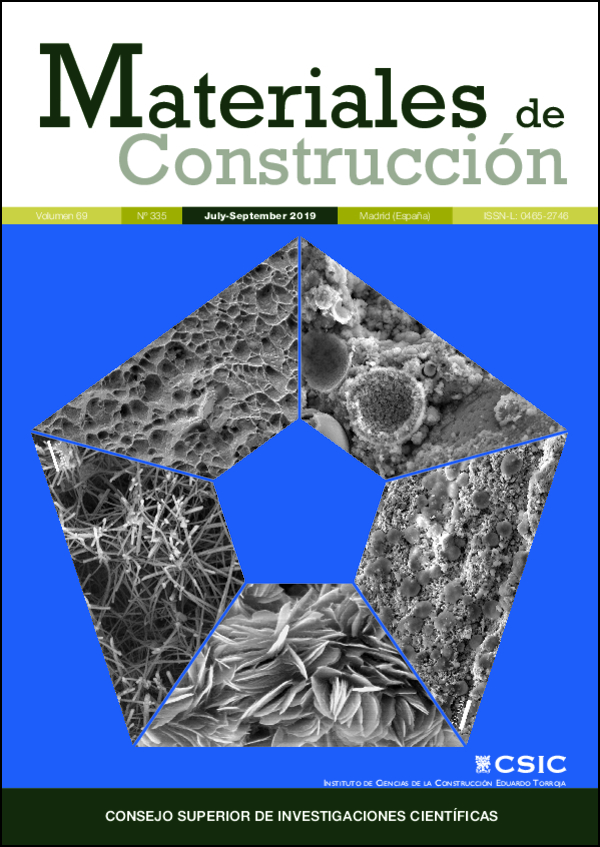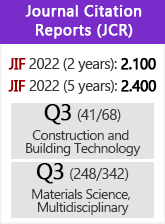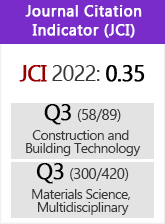Development of flame retarded composite fibreboard for building applications using oil palm residue
DOI:
https://doi.org/10.3989/mc.2019.10418Keywords:
Composite, Characterization, Fibre reinforcement, Polymer, FillerAbstract
Residential housing is a critical aspect of human living and in developing countries this is a mirage due to high cost of building materials. In order to meet the needs for affordable housing with low cost materials as well as meet required fire safety standards, this research developed flame retarded fibreboards with oil palm residue reinforced in polyester resin, incorporating 0, 12 and 18% flame retardant loading using hand lay-up compression moulding. The fibreboards were tested for impact, thermal and flammability properties. Based on experiments, it was found that 12% aluminum tri-hydroxide fibreboard meets the impact and thermal limitations while the 18% hybrid formulation meets the required fire safety standard for building interior applications which will benefit rural dwellers in Nigeria and in similar climes around the world seeking to substitute conventional materials with the advantage of low cost, easy to process, biodegradable, environmentally benign and flame retarded composite material.
Downloads
References
Nigeria Pollution Growth Rate (2018) www.worldmeters. info
Akinyemi, A.B.; Afolayan, J.O.; Oluwatobi, E.O. (2016) Some Properties of Composite Corn Cob and Sawdust Particle Boards. Construc. Build. Mat. 127, 436-441. https://doi.org/10.1016/j.conbuildmat.2016.10.040
Adedeji, Y.M.D.; Ajayi, B. (2008) Cost Effective Composite Building Panels for Walls and Ceilings in Nigeria" in 11th Int. Inorganic-Bonded Fiber Composite Conference
Sukyai, P.; Sriroth, K.; Lee, B.K.; Kim, H.J. (2012) The Effect of Bacterial Cellulose on the Mechanical and Thermal Expansion Properties of Kenaf/Poly Lactic Acid Composites. Applied Mechanics and Materials. 117-119, 1343-1351. https://doi.org/10.4028/www.scientific.net/AMM.117-119.1343
Myrtha, K.; Halia, O.; Dawam, A.A.H.; Anung, S. (2008) Effect of Oil Palm Empty Fruit Bunch Fibre on the Physical and Mechanical Properties of Fibre Glass Reinforced Polyester Resin. J. Biol. Sci.. 8(1), 101-106. https://doi.org/10.3923/jbs.2008.101.106
Shukor, F.; Hassan, A.; Saiful Islam, M.; Morkhtar, M.; Hasan, M. (2014) Effect of Ammonium Polyphosphate on the Flame Retardancy, Thermal Stability and Mechanical Properties of Alkali Treated Kenaf Fibre Filled PLA Biocomposites. Mater.Des. 54, 425-429. https://doi.org/10.1016/j.matdes.2013.07.095
Khalili, P.; Tshai, K.Y.; Kong, I. (2017) Natural Fibre Reinforced Expandable Graphite Filled Composites: Evaluation of the Flame Retardancy, Thermal and Mechanical Performances. Composites Part A. 100, 194- 205. https://doi.org/10.1016/j.compositesa.2017.05.015
Suoware, T.O.; Ezema, I.C.; Edelugo, S.O. (2017) Flammability of Flame Retarded Natural Fibre Composites and Application in Automobile Interior: A Review. Imp. J. Interdisc. Res. (IJIR) ISSN: 2454-1362, 3(8), 587-600.
Mallick, P.K. (1990) Compression Moulding, Composite materials Technology. (Mallick P.K.; Newman, S. eds.), Hanser Publishers, New York.
Ishai, O.; Daniel, I.M. (2006) Engineering Mechanics of Composite Materials, Second Edition, New York, Oxford University Press, 12-77.
Subastinghe, A.; Bhattacharya, D. (2014) Performance of Different Intumescent Ammonium Polyphosphate Flame Retardants in PP/Kenaf Fibre Composites. Composites Part A, 65, 91-99. https://doi.org/10.1016/j.compositesa.2014.06.001
Norzali, N.A.R.; Badri, K.H.; Nuawi, M.Z. (2011) Loading Effect of Aluminum Hydroxide onto the Mechanical, Thermal Conductivity, Acoustical and Burning Properties of the Palm-based Polyurethane Composites. Sains Malaysiana 40(7), 737-742.
Redwan, A M.; Badri, K.H.; Tarawneh, M.A. (2015) The effect of Aluminium hydroxide on the Mechanical Properties of Fire Resistivity of Palm-Based Fiberborad prepared by Pre-Polymerization Method. Adv. Mat. Res. 1087, 287-292. https://doi.org/10.4028/www.scientific.net/AMR.1087.287
Arjmandi, R.; Ismail, A.; Hassan, A.; Abu Bakar, A (2017) Effects of Ammonium Polyphosphate Content on Mechanical, Thermal and Flammability Properties of Kenaf/Polypropylene and Rice Husk/Polypropylene Composites. Construc. Build. Mat. 152, 484-493. https://doi.org/10.1016/j.conbuildmat.2017.07.052
Woo, Y.; Donghwon, C. (2013) Effect of Aluminium Trihydroxide on Flame Retardancy and Dynamic Mechanical and Tensile Properties of Kenaf/poly (Lactic Acid) Green Composites" Adv. Comp. Mat.; 22, 6: 451-464. https://doi.org/10.1080/09243046.2013.843831
Ramazani, S.A.; Rahimi, A.; Frounchi, M.; Radman, A. (2008) Investigation of Flame Retardancy and Physical- Mechanical Properties of Zinc Borate and Alumnium Hydroxide Propylene Composites. Mater. Des. 29, 1051-1056. https://doi.org/10.1016/j.matdes.2007.04.003
Alhuthali, A.; Low, I.M.; and Dong, C. (2012) Characterization of the Water Absorption, Mechanical and Thermal Properties of Recycled Cellulose Fibre Reinforced VinylEster Eco- Nanocomposites. Composites Part B: Engineering. 43(7), 2772-2781. https://doi.org/10.1016/j.compositesb.2012.04.038
Stark, N.M.; White, R.H.; Mueller, S.A.; Osswald, T.A. (2010) Evaluation of various Fire Retardants for use in Wood Flour-Polyethylene Composites. Polym. Degrad. Stab. 95, 1903-1910. https://doi.org/10.1016/j.polymdegradstab.2010.04.014
Zhao, X L.; Chen, C.K.; Chen, X.L. (2016) Effects of Carbon Fibers on the Flammability and Smoke Emission Characteristics of Halogen-Free Thermoplastic Polyurethane/Ammonium Polyphosphate. J. Mater. Sci. 51, 3762-3771. https://doi.org/10.1007/s10853-015-9694-5
Carosio, F.; Alongi, J.; Malucelli, G. (2012) Layer by Layer Ammonium Polyphosphate-Based Coatings for Flame Retardancy of Polyester-Cotton Blends. Carbohydr. Polym. 88, 1460-1469. https://doi.org/10.1016/j.carbpol.2012.02.049
Idris, U.D.; Aigbodion, V.S.; Atuanya, C.U.; Abdullahi, J. (2011) Eco-Friendly (Water Melon Peels): Alternative to Wood-Based Particleboard Composite. The pacific Journal of Science and Technology. 12(2), 112-119.
Obam, S.O. (2010) Properties of Sawdust, Paper and Starch Composite Ceiling Board. Am.J. Sci. Ind. Res. ISSN: 2153-649X, 300-304. https://doi.org/10.5251/ajsir.2012.3.5.300.304
Olorunmaiye, J.A.; Ohijeagbon, I.O. (2015) Retrofitting Composite Ceiling Boards with Jatropha Curcas Seedcake Material. J. Prod. Eng. 18(2), 96-102.
Amenaghawon, N.A.; Osayuki-Aguebor, W.; Okiemen, C.O. (2016) Production of Particle Boards from Corn Cobs and Cassava Stalks: Optimization of mechanical properties using Response Surface Methodology. J. Mater. Environ. Sci. 7(4), 1236-1244.
Vijaya, S.; Ravi, N.M.; Helmi, S.; Choo, Y.M. (2013) The Development of a Residual Oil Recovery System to Increase the Revenue of Palm Oil Mill. J. Oil Palm Res., 25(1), 116-122.
Ezema, I.C. (2015) Development of Mass Fraction Prediction Model for a Unidirectional Fiber Reinforced Polymer Composites. Unpublished Ph. D Thesis submitted to Mechanical Engineering Department, University of Nigeria Nsukka. April (2015), 82-83.
Nikmatin, S.; Syafiuddin, A.; Irewanto, D.A. (2017) Properties of Oil Palm Empty Fruit Bunch -Filled Recycled Acrylonitrile Butadiene Styrene Composites: Effect of Shapes and Filler Loadings with Random Orientation" BioResources 12(1), 1090-1101. https://doi.org/10.15376/biores.12.1.1090-1101
Subasinghe, A.; Das, R.; Bhattacharyya, D. (2016) Study of Thermal, Flammability and Mechanical Properties of Intumescent Flame Retardant PP/Kenaf Nanocomposites. Internal Journal of Smart and Nano materials. 7(3), 202-220. https://doi.org/10.1080/19475411.2016.1239315
Guidicianni, P; Cardone, G.; Ragucci, R. (2013) Cellulose, Hemicellulose and Lignin Slow Steam Pyrolysis: Thermal Decomposition of Biomass Components Mixtures" J. Anal. Appl. Pyrolysi. 100, 213-222. https://doi.org/10.1016/j.jaap.2012.12.026
Belouadah, Z.; Ati, A.; Rokbi, M. (2015) Characterization of New Cellulose Fibre from Lygeum Spartum L. Carbohydrate Polymers. 134, 429437. https://doi.org/10.1016/j.carbpol.2015.08.024 PMid:26428144
Hapuarachchi, T.D. (2010) Development and Characterization of Flame Retardant Nanoparticulate Bio-based Polymer Composites. PhD thesis submitted to the University of London.
Le Bras, M.; Bourbigot, S. In: Le Bras M, Camino, G., Bourbigot, S., and Delobel, R., Editors (1998) Fire Retarded Intumescent Thermoplastic Formulations, Synergy and Synergistic Agent-A Review. The Royal Society of Chemistry, Cambridge, 64-75. https://doi.org/10.1533/9781845698584.2.64
Schartel, B.; Braun, U. (2003) Fourteenth Annual BCC Conference on Flame Retardancy, Fire Retarded Polypropylene/Flax. Biocomposties. 219-228.
Nikolaeva, M.; Karki, T. (2016) Influence of Fire Retardants on the Reaction-to-Fire Properties of Coextruded Wood-Polypropylene Composites. Fire Mat. 40, 535-543. https://doi.org/10.1002/fam.2308
Long, Y.; Zhisheng, X.; Jun, Z. (2017) Influence of Nanoparticle Geometry on the Thermal Stability and Flame Retardancy of High-Impact Polystyrene Nanocomposites. J. Thermal Anal Calorim. 130, 1987-1996. https://doi.org/10.1007/s10973-017-6514-y
Xin, W.; Yujie, W.W.; Jiang, W.G.; Jie, L.; Nana, T.; Yanhui, W.; Zhiwei, J.; Jian, Q.; Tao, T. (2012) Thermal and Flammability Properties of Polypropylene/Carbon Black Nanocomposites Polym. Degrad. Stab. 97, 793-801. https://doi.org/10.1016/j.polymdegradstab.2012.01.031
Published
How to Cite
Issue
Section
License
Copyright (c) 2019 Consejo Superior de Investigaciones Científicas (CSIC)

This work is licensed under a Creative Commons Attribution 4.0 International License.
© CSIC. Manuscripts published in both the printed and online versions of this Journal are the property of Consejo Superior de Investigaciones Científicas, and quoting this source is a requirement for any partial or full reproduction.All contents of this electronic edition, except where otherwise noted, are distributed under a “Creative Commons Attribution 4.0 International” (CC BY 4.0) License. You may read here the basic information and the legal text of the license. The indication of the CC BY 4.0 License must be expressly stated in this way when necessary.
Self-archiving in repositories, personal webpages or similar, of any version other than the published by the Editor, is not allowed.


















